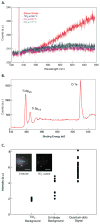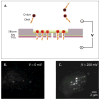Fabrication and characterization of solid-state nanopore arrays for high-throughput DNA sequencing
- PMID: 22948520
- PMCID: PMC3557807
- DOI: 10.1088/0957-4484/23/38/385308
Fabrication and characterization of solid-state nanopore arrays for high-throughput DNA sequencing
Abstract
We report the fabrication and characterization of uniformly sized nanopore arrays, integrated into an optical detection system for high-throughput DNA sequencing applications. Nanopore arrays were fabricated using focused ion beam milling, followed by TiO(2) coating using atomic layer deposition. The TiO(2) layer decreases the initial pore diameter down to the sub-10 nm range, compatible with the requirements for nanopore-based sequencing using optical readout. We find that the TiO(2) layers produce a lower photoluminescence background as compared with the more widely used Al(2)O(3) coatings. The functionality of the nanopore array was demonstrated by the simultaneous optical detection of DNA-quantum dot conjugates, which were electro-kinetically driven through the nanopores. Our optical scheme employs total internal reflection fluorescence microscopy to illuminate a wide area of the TiO(2)-coated membrane. A highly parallel system for observing DNA capture events in a uniformly sized 6 × 6 nanopore array was experimentally realized.
Figures






Similar articles
-
Towards rapid DNA sequencing: detecting single-stranded DNA with a solid-state nanopore.Small. 2006 Mar;2(3):310-2. doi: 10.1002/smll.200500464. Small. 2006. PMID: 17193041 Review. No abstract available.
-
Solid-state nanopore technologies for nanopore-based DNA analysis.Nanomedicine (Lond). 2007 Dec;2(6):875-97. doi: 10.2217/17435889.2.6.875. Nanomedicine (Lond). 2007. PMID: 18095852 Review.
-
Precise electrochemical fabrication of sub-20 nm solid-state nanopores for single-molecule biosensing.J Phys Condens Matter. 2010 Nov 17;22(45):454128. doi: 10.1088/0953-8984/22/45/454128. Epub 2010 Oct 29. J Phys Condens Matter. 2010. PMID: 21339614
-
Single-molecule sensing electrode embedded in-plane nanopore.Sci Rep. 2011;1:46. doi: 10.1038/srep00046. Epub 2011 Jul 28. Sci Rep. 2011. PMID: 22355565 Free PMC article.
-
Real-time single-molecule electronic DNA sequencing by synthesis using polymer-tagged nucleotides on a nanopore array.Proc Natl Acad Sci U S A. 2016 May 10;113(19):5233-8. doi: 10.1073/pnas.1601782113. Epub 2016 Apr 18. Proc Natl Acad Sci U S A. 2016. PMID: 27091962 Free PMC article.
Cited by
-
Two color DNA barcode detection in photoluminescence suppressed silicon nitride nanopores.Nano Lett. 2015 Jan 14;15(1):745-52. doi: 10.1021/nl504459c. Epub 2014 Dec 22. Nano Lett. 2015. PMID: 25522780 Free PMC article.
-
Optically-Monitored Nanopore Fabrication Using a Focused Laser Beam.Sci Rep. 2018 Jun 27;8(1):9765. doi: 10.1038/s41598-018-28136-z. Sci Rep. 2018. PMID: 29950607 Free PMC article.
-
High bandwidth approaches in nanopore and ion channel recordings - A tutorial review.Anal Chim Acta. 2019 Jul 11;1061:13-27. doi: 10.1016/j.aca.2019.01.034. Epub 2019 Jan 25. Anal Chim Acta. 2019. PMID: 30926031 Free PMC article. Review.
-
Next generation plant biostimulants & genome sequencing strategies for sustainable agriculture development.Front Microbiol. 2024 Jul 17;15:1439561. doi: 10.3389/fmicb.2024.1439561. eCollection 2024. Front Microbiol. 2024. PMID: 39104588 Free PMC article. Review.
-
The evolution of nanopore sequencing.Front Genet. 2015 Jan 7;5:449. doi: 10.3389/fgene.2014.00449. eCollection 2014. Front Genet. 2015. PMID: 25610451 Free PMC article. Review.
References
Publication types
MeSH terms
Substances
Grants and funding
LinkOut - more resources
Full Text Sources
Other Literature Sources
